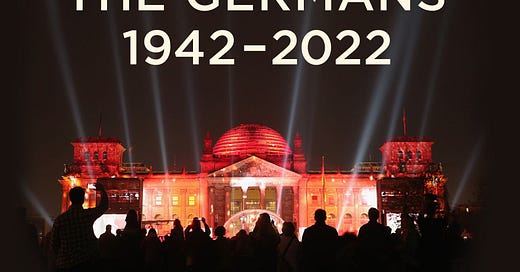Review: J. S. Marcus on a new history of postwar Germany
Making the case that nothing really ever settled down in this part of Europe after 1945, which was marked by wave after wave of dislocation and relocation.
German history, like everyone’s history, is filled with what could be called natural borders—specific events that seem to separate what came before from what came after. 800, the year that Charlemagne was crowned in Rome, marking the beginning of Germany’s first Reich, is one; 1871, when the new unified German nation (the “second” Reich) was declared in Versailles’s Hall of Mirrors, is another. In his new, vast, and selective history of post-World War II Germany, Frank Trentmann starts in what feels like the middle of nowhere—in the moral black hole that was the Third Reich just after its military and geographic peak, when everything about the future was suddenly in doubt.
Out of the Darkness: The Germans, 1942–2022 begins in a familiar scene. A defeated and devastated Germany, its diabolical war machine in ruins, is split in two. The western two thirds of the rump German nation, haunted by its crimes, rebuilds and recovers, anchoring itself in an increasingly unified continent and using its regained prosperity to buy itself back a place among civilized nations. The eastern third is kept as a Soviet satellite, rebuilding, to some extent, and recovering after a fashion, while developing into a distorted version of its would-be doppelgänger—until world events change course in 1989, and it is swallowed up whole, for the benefit of some but not all.
Trentmann—a London-based, West-German-born professor of both British and German history—has his sights set on the Cold War era, whose twists and turns are often effectively dramatized with facts and figures. Phoenix-like West Germany, a wasteland overwhelmed with millions of refugees in 1947, reached full employment in 1957. In the mid-1950s, there were around thirty thousand secret police informers in East Germany, which didn’t become a full-blown surveillance state until after the Berlin Wall was built in 1961; by 1989, there 189,000 informers. And so on.
Numbers aside, Trentmann’s technique is not to emphasize—or, in some cases, even to mention—important political events; rather, he draws on several decades of letters, diaries, and testimonials. A deft miniaturist, he can pinpoint and characterize the fates of German war criminals, West German guest workers, and East German appliance owners with great skill and remarkable empathy.
Keep reading with a 7-day free trial
Subscribe to Book Post to keep reading this post and get 7 days of free access to the full post archives.



